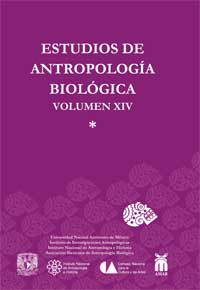Baptisms in Mixquiahuala, Hidalgo, 1681-1740
DOI:
https://doi.org/10.22201/iia.14055066p.2009.27206Keywords:
historical demography, birth seasonality, population changeAbstract
Historical demographic studies of Mexican indigenous communities have the potential to shed light on Precolumbian population structure as well as that of the Colonial populations that they directly examine. Baptismal records from San Anto- nio Mixquiahuala and San Juan Tecpatepec, Hidalgo, for the period 1681-1740 were compiled, a total of 5 784 records. Patterns of annual and seasonal variation were examined. Although there was much annual fluctuation in number of births, the secular increase was minimal, suggesting a stable population over this period. With a census population of 1 381 from 1 718, the annual (1716-1720) mean number of 95.8 births equals 6.9 per 100 population, with 33.4% of the married couples having a child per year. Baptisms were more common in winter and spring, and less common in summer and fall, suggesting that most conceptions occurred in spring and summer. To test the correlation between population and climate, tree-ring data were used. There was a significant correlation between annual rainfall, as indicated by tree-ring width in Río Verde, San Luis Potosí, and the number of births in Mixquiahuala two years later. Because tree-ring data are available from the Precolumbian period, they may offer insight into prehispanic population dynamics as well.
Downloads
Downloads
How to Cite
Issue
Section
License

http://creativecommons.org/licenses/by-nc-nd/4.0/


